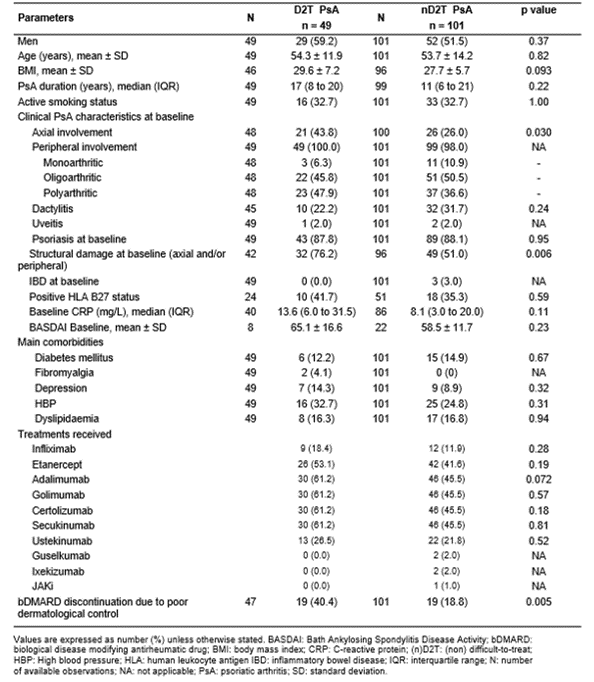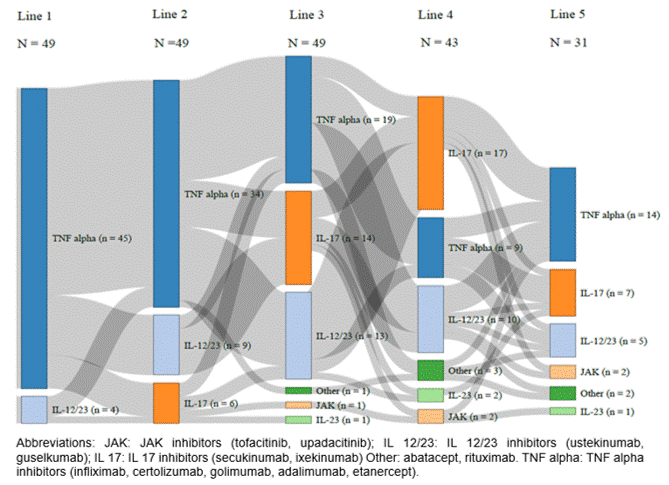Session Information
Date: Sunday, November 12, 2023
Title: Abstracts: Spondyloarthritis Including Psoriatic Arthritis – Treatment I: PsA
Session Type: Abstract Session
Session Time: 2:00PM-3:30PM
Background/Purpose: The EULAR task force recently published the difficult-to-treat RA (D2T RA) definition [1], however, a definition of D2T PsA is still lacking. To date, we have little data concerning D2T PsA, especially in real-world. One of the limitations of the D2T RA EULAR definition is the absence of a temporal criterion. The primary endpoint of this work was to study the characteristics of D2T PsA patients using the EULAR definition. The second objective was to study a sub-group of patients with a predefined more stringent definition including a temporal criterion.
Methods: A retrospective study was performed in a tertiary center. PsA patients 18 years old or older starting a b/tsDMARDs with at least two-year follow-up were included. D2T PsA was defined as failure of ≥ 2 b/tsDMARDs with different mechanism of action among TNF inhibitors, anti-IL 17, anti-IL 23 and JAK inhibitors. Very D2T PsA was defined as failure of ≥ 2 b/tsDMARDs in less than 2 years of follow-up. D2T and Very D2T PsA patient’s characteristics were compared between with non-D2T (nD2T) patients using statistical tests. The significant factors at the level of 0.10 were introduced into a multivariable multinomial logistic regression model.
Results: 150 PsA patients were included: 49 D2T PsA (32.7%) and 101 non-D2T (nD2T) PsA (67.3%). Results showed a significant difference in clinical PsA features at baseline including axial involvement, with a proportion of 43.8% in the D2T group vs. 26.0% in the nD2T group (p=0.03) (Table 1). Structural damage at baseline (axial and/or peripheral) concerned 76.2% of the D2T patients and 51.0% of the nD2T patients (p=0.006). In multivariate analysis, structural damage was found to be a predictive factor for D2T PsA with an OR of 2.49 (1.05 to 5.89; p=0.038) (Table 2).
There was no significant difference regarding comorbidities such as obesity, smoking status, fibromyalgia or depression. The median delay to first b/tsDMARD in the D2T group was 42 (12 to 120) months vs. 36 (14,5 to 108) months in the nD2T group (p=0,95). Treatment trajectory of D2T PsA patients were reported from 1st to 5th line (Figure 1). There was at least one therapeutic switch for dermatological ineffectiveness in 40.4% of patients in the D2T group vs 18.8% in the nD2T group (p=0.005). In multivariate analysis, bDMARD discontinuation due to poor dermatological control was found to be more frequent in the D2T population with an OR of 2.75 (1.23 to 6.14; p=0.013) (Table 2).
17 patients (11.3%) were categorized as Very D2T. When compared to the nD2T group, proportion of obesity was higher (p=0.015) and axial involvement at baseline was more prevalent in the Very D2T group (p=0.020).
Conclusion: D2T PsA was associated with a higher prevalence of axial involvement, structural damage and therapeutic discontinuation due to poor dermatological control. Very D2T PsA patients were more likely obese with axial involvement. Very D2T PsA represent a minim proportion of patients when applying a more stringent definition. Pending the PsA D2T definition by the European and American societies, this study highlights some characteristics that may help practitioners better identify D2T patients.
1 Nagy G et al. EULAR definition of difficult-to-treat rheumatoid arthritis. Ann Rheum Dis 2021;80:31–5.
To cite this abstract in AMA style:
PHILIPPOTEAUX C, Marty-Ane A, Cailliau E, Philippe P, Cortet B, Paccou J, Flipo R, Letarouilly J. Characteristics of Difficult-To-Treat Psoriatic Arthritis: A Comparative Analysis [abstract]. Arthritis Rheumatol. 2023; 75 (suppl 9). https://acrabstracts.org/abstract/characteristics-of-difficult-to-treat-psoriatic-arthritis-a-comparative-analysis/. Accessed .« Back to ACR Convergence 2023
ACR Meeting Abstracts - https://acrabstracts.org/abstract/characteristics-of-difficult-to-treat-psoriatic-arthritis-a-comparative-analysis/



